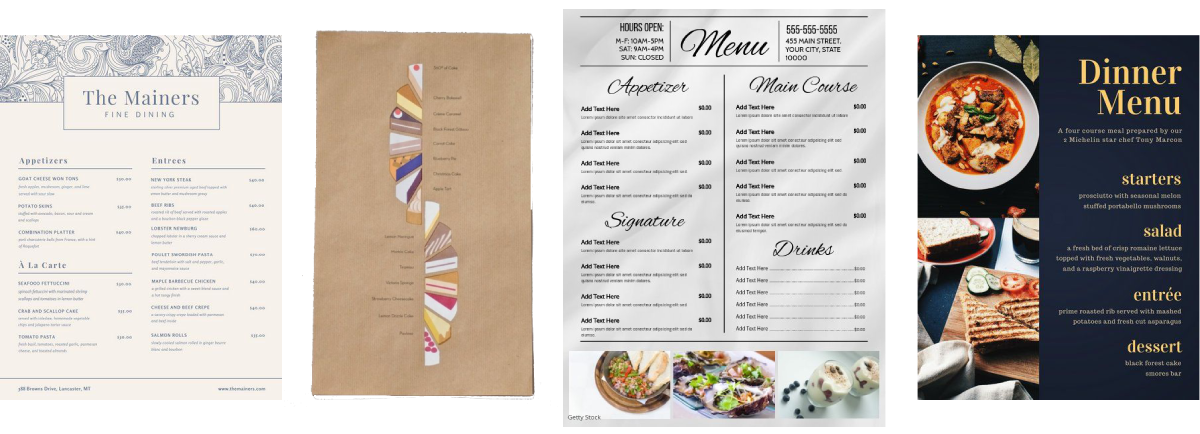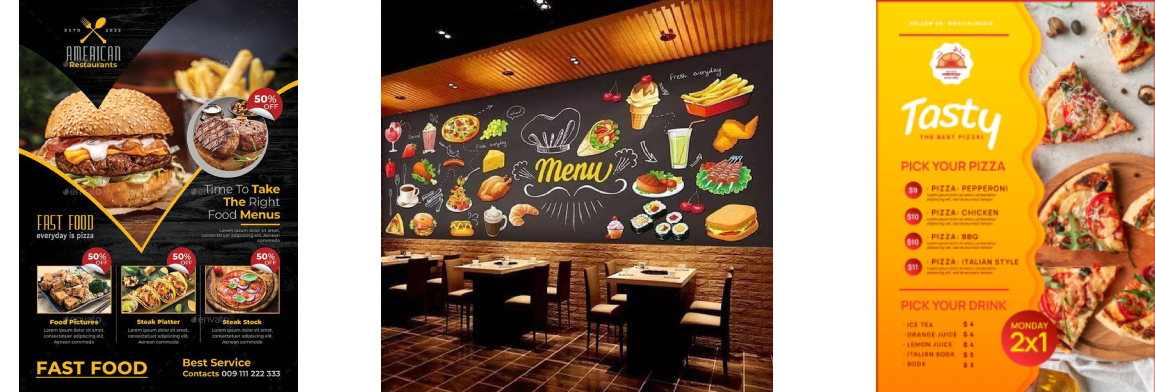Menu Management: A Crucial Process in the lifecycle of a Restaurant
Menu management refers to the process of designing, creating, updating, and organizing menus in a restaurant, café, or any food service establishment. Effective menu management plays a critical role in the success of any food business as it can impact customer satisfaction, sales, and profitability.
Here are some key aspects of menu management:
- Menu design: Creating an attractive, easy-to-read menu that showcases the restaurant’s brand, highlights the most profitable items, and meets the customers’ needs.
- Menu pricing: Setting prices for each menu item based on the cost of ingredients, labor, and overhead, as well as the target customer demographic, competition, and market demand.
- Menu engineering: Analyzing sales data to determine which menu items are popular, profitable, and underperforming. The goal is to optimize the menu mix by promoting bestsellers, adjusting prices, and redesigning menu layouts.
- Menu organization: Grouping menu items into logical categories, such as appetizers, entrees, and desserts, and arranging them in a way that is easy for customers to navigate.
- Menu updates: Adding new items, removing unpopular items, and adjusting prices to reflect changes in ingredient costs or customer demand. Menu updates should be done regularly to keep the menu fresh and exciting.
Effective menu management requires a thorough understanding of the restaurant’s target market, brand identity, and financial goals. By regularly reviewing and updating the menu, restaurant owners and managers can keep their offerings fresh and relevant, attract new customers, and boost profitability.

- Menu design plays a crucial role in attracting customers and influencing their purchasing decisions in a food establishment. Effective menu design requires a balance between creativity and functionality, with the aim of creating a visually appealing and easy to navigate menu that highlights the restaurant’s brand, products and offerings while also driving sales. Here are some key aspects of menu design:
- Layout: The menu layout should be easy to read and navigate. Important items like the restaurant name, logo, and menu headings should be prominently displayed. Items should be organized in logical categories, such as appetizers, entrees, and desserts, to make it easier for customers to find what they’re looking for.
- Typography: The font type and size should be easy to read and match the restaurant’s brand identity. Using too many font types or styles can make the menu look cluttered and confusing. The use of colors can also be helpful in highlighting important items or categories.
- Descriptions: The menu descriptions should be concise, yet informative, highlighting the key ingredients and flavors of each dish. Well-written descriptions can entice customers to try new items and increase sales.
- Images: High-quality images of menu items can be used to enhance the visual appeal of the menu and give customers an idea of what to expect. However, it is important to ensure that the images accurately represent the actual dish.
- Pricing: The prices should be clearly displayed and formatted in a way that is easy to read. Using simple formatting, such as a grid or columns, can make it easier for customers to compare prices.
- Specials and promotions: Specials and promotions can be highlighted on the menu using design elements such as borders, icons, or highlighted boxes, to attract customers’ attention.
Menu pricing is a critical aspect of menu management in a food establishment. Setting the right prices for menu items requires balancing the cost of ingredients, overhead, labor, and profit margins, while also considering factors such as the target market, competition, and market demand. menu pricing requires a comprehensive understanding of the business’s costs, target market, and competition. A well-designed pricing strategy can help to maximize sales, increase profitability, and create a loyal customer base. Some key aspects of menu pricing are as below:

- Cost of goods sold: Menu items should be priced based on the cost of ingredients, including food, beverages, and packaging. Accurate cost calculations are essential to ensure that the menu items are priced correctly to cover the costs and maintain profit margins.
- Overhead and labor costs: Overhead and labor costs, such as rent, utilities, and employee wages, should also be factored in while pricing menu items.
- Target market: The pricing strategy should be aligned with the target market’s willingness to pay, expectations, and purchasing power. Pricing should be attractive enough to retain customers while also ensuring that it meets the business’s financial goals.
- Competition: Competitive pricing analysis can provide insights into the pricing of similar menu items in other food establishments. Based on this analysis, pricing can be adjusted accordingly to maintain a competitive edge.
- Profit margin: The menu items should be priced in a way that ensures that the business meets its profit goals. This can involve calculating a target profit margin or setting prices based on markup percentage.
- Seasonal pricing: Seasonal pricing can be applied to menu items to account for variations in the cost of ingredients and market demand during different times of the year.
Menu Engineering is a data-driven approach to menu management that involves analyzing the performance of menu items to optimize the menu mix, maximize profitability, and enhance customer satisfaction.
Menu engineering requires a thorough understanding of the business’s sales data, costs, and customer preferences. By using data-driven analysis to optimize the menu mix and pricing strategies, restaurants can increase profitability, customer satisfaction, and loyalty.
A few noteworthy pointers to keep in mind while conducting the Menu Engineering Process are as follows:
- Menu item analysis: Menu items are analyzed based on their popularity and profitability. Items that sell well but have low profit margins are considered “stars,” while items with low sales and high profit margins are considered “dogs.”
- Menu optimization: The goal of menu engineering is to optimize the menu mix by promoting best-selling items, adjusting prices, and redesigning the menu layout to highlight profitable items.
- Menu item placement: Menu items are placed strategically on the menu to increase sales. Popular items are often placed in prime locations, such as the top or bottom of the menu or in boxes, while high-profit items are placed next to or above popular items.
- Menu item descriptions: Well-written menu item descriptions can increase sales and customer satisfaction. Descriptions should be concise yet informative, highlighting the key ingredients and flavors of each dish.
- Menu pricing: Menu engineering can help determine optimal pricing strategies to maximize profitability, such as increasing prices of popular items or reducing prices of low-performing items.
- Menu updates: Regular menu updates are crucial to keep the menu fresh and exciting. Menu engineering can help determine which items to add or remove based on their popularity and profitability.
Menu organization is the process of categorizing and presenting menu items in a clear and logical way to make it easier for customers to make informed decisions. To make an impact, menu organization requires a balance between creativity and functionality, with the aim of creating a visually appealing and easy to navigate menu that highlights the restaurant’s brand, products, and offerings while also driving sales.

Here are some key aspects of menu organization:
- Menu categories: Menu items should be categorized based on their type, such as appetizers, entrees, desserts, and beverages. This makes it easier for customers to navigate the menu and find what they’re looking for.
- Item descriptions: Each menu item should have a clear and concise description that highlights its key ingredients and flavors. This helps customers make informed decisions about what to order.
- Special diets: Many customers have special dietary needs or preferences, such as gluten-free, vegetarian, or vegan. Menu items should be labeled accordingly to help customers identify suitable options.
- Pricing: The prices of menu items should be displayed clearly and formatted in a way that is easy to read. Using a grid or columns can make it easier for customers to compare prices.
- Menu layout: The menu layout should be visually appealing and easy to navigate. Important items, such as the restaurant name, logo, and menu headings, should be prominently displayed. Popular or profitable items can be highlighted using design elements such as borders or icons.
- Seasonal items: Some restaurants may offer seasonal items that are only available for a limited time. These items should be clearly labeled and displayed separately on the menu to create excitement and encourage customers to try them.
Menu updation is an important aspect of running a successful restaurant. Here are some things to consider when updating your restaurant menu:
- Keep up with the latest trends: Research the latest food trends and incorporate them into your menu. Customers are always looking for something new and exciting, so make sure to offer unique and innovative dishes.
- Analyze your current menu: Look at your current menu and determine which items are popular and which ones are not. Consider removing items that are not selling well and replacing them with new dishes.
- Get customer feedback: Ask your customers for their feedback on your menu. This can be done through surveys or by simply talking to them. Take their feedback into consideration and make changes accordingly.
- Seasonal changes: Update your menu to reflect the seasons. Use seasonal ingredients and flavors to create dishes that are fresh and relevant.
- Pricing: Review your pricing strategy and adjust accordingly. Make sure your menu items are priced correctly based on the cost of ingredients, preparation time, and market demand.
- Keep it simple: Don’t overload your menu with too many items. Offer a focused menu with a few high-quality options that showcase your restaurant’s unique style and flavors.
- Keep it consistent: Ensure that the quality and presentation of your menu items are consistent. This will help build customer loyalty and maintain a positive reputation for your restaurant.
Overall, updating your restaurant menu is an ongoing process that requires research, customer feedback, and attention to detail. By keeping your menu fresh and relevant, you can attract new customers and keep your regulars coming back for more.
For a proper consultation on your current menu and engineering it, to fit your profitability, do connect with me on parikshitkarnik@gmail.com
By,
Parikshit Karnik
